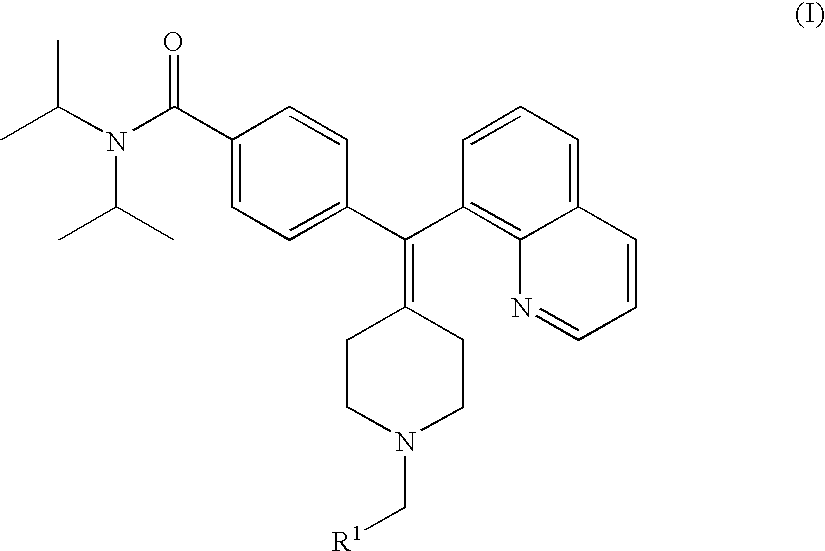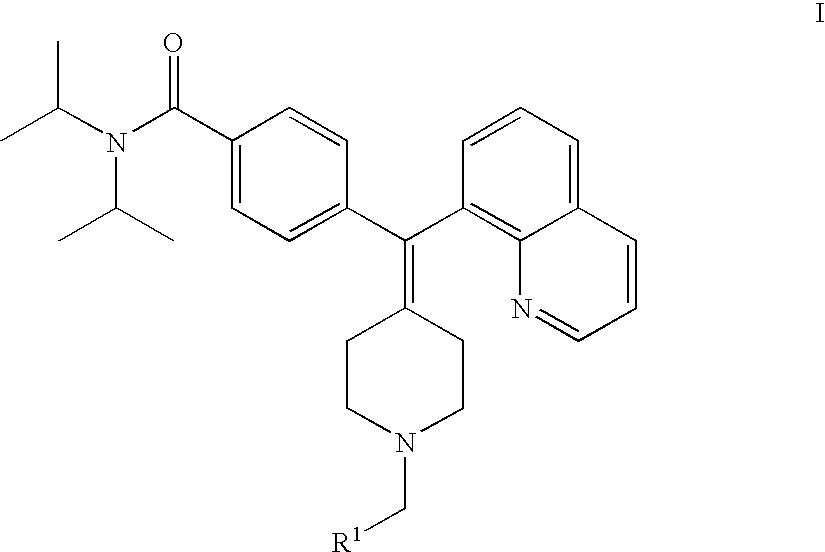4-(phenyl-piperdin-4-ylidene methyl)-benzamide derivatives and their use for the treatment of pain, anxiety or gastrointestinal disorders
a technology of benzamide and phenylpiperdin, which is applied in the direction of immunological disorders, drug compositions, biocides, etc., can solve the problems of poor pharmacokinetics, unsuitable systemic administration of opioid ligands, and peptides
- Summary
- Abstract
- Description
- Claims
- Application Information
AI Technical Summary
Benefits of technology
Problems solved by technology
Method used
Image
Examples
examples 1-12
were synthesized following the general synthetic procedure depicted below.
The synthesis of Example 1, below is typical.
example 1
4-[1-(1-Benzyl-piperidin-4-ylidene)-1-quinolin-8-yl-methyl]-N,N-diisopropyl-benzamide
To a solution of amine (8) (451 mg, 1.05 mmol, 1.0 equiv.) in tetrahydrofuran (20 ml) at room temperature was added benzaldehyde (129 μl, 1.27 mmol, 1.2 equiv.). After stirring for 10 minutes sodium triacetoxyborohydride (292 mg, 1.38 mmol, 1.3 equiv.) was added to the solution. After stirring overnight, the reaction mixture was diluted with dichloromethane (10 ml) and 2M aqueous sodium hydroxide solution (15 ml). The phases were separated and the organic phase washed with brine (15 ml). The former aqueous phase is back-extracted with dichloromethane three times (15 ml). The organic phases were combined, dried with sodium sulfate, filtered and concentrated under reduced pressure. The crude product was purified by flash chromatography eluting with 5% methanol in dichloromethane. The fraction was concentrated under reduced pressure and diluted in diethyl ether and dichloromethane. To this mixture was ...
examples 2-12
were prepared analogously. Analytical data for Examples 1-12 are in Table 1 below.
TABLE 1Analytical Data, for Compounds of the Present Invention.Ex. #R1NameNMR data (400 MHz)14-[1-(1-Benzyl- piperdin-4-ylidene)-1- quinolin-8-yl-methyl]- N,N-diisopropyl- benzamide.(400 MHz, DMSO), 9.01 (m, 1H, Ar-H); 8.65 (m, 1H, Ar-H); 8.05 (br s, 1H, Ar-H); 7.72 (m, 3H, Ar-H); 7.54 (br s, 2H, Ar-H); 7.39 (s, 3H, Ar-H); 7.34 (d, J = 7.4 Hz, 2H, Ar-H); 7.15 (m, 2H, Ar-H); 4.25 (m, 2H, NCH2Ar); # 3.55 (br s, 1H, NCH); 3.40 (m, 2H, CH2); 3.20 (m, 1H, CH2); 3.03 (m, 2H, CH2, NCH2); 2.72 (m, 2H, NCH2); 2.41 (m, 2H, NCH2); 1.16 (m, 12H, CH3)2N,N-Diisopropyl-4-[1- (1-pyridin-2-ylmethyl- piperidin-4-ylidene)-1- quinolin-8-yl-methyl]- benzamide.(400 MHz, DMSO) 9.15 (m, 1H, Ar-H); 8.90 (m, 1H, Ar-H); 8.62 (d, J = 4.6 Hz, 1H, Ar-H); 8.17 (m, 1H, Ar-H); 7.87 (m, 4H, Ar-H); 7.65 (m, 1H, Ar-H); 7.43 (m, 3H, Ar-H); 7.16 (d, J = 7.4 Hz, 2H, Ar-H); 4.43 (s, 2H, # NCH2Ar); 3.55 (br s, 3H, NCH, CH2); 3.33 (m, 2H, CH2)...
PUM
| Property | Measurement | Unit |
|---|---|---|
| stability | aaaaa | aaaaa |
Abstract
Description
Claims
Application Information
 Login to View More
Login to View More - R&D
- Intellectual Property
- Life Sciences
- Materials
- Tech Scout
- Unparalleled Data Quality
- Higher Quality Content
- 60% Fewer Hallucinations
Browse by: Latest US Patents, China's latest patents, Technical Efficacy Thesaurus, Application Domain, Technology Topic, Popular Technical Reports.
© 2025 PatSnap. All rights reserved.Legal|Privacy policy|Modern Slavery Act Transparency Statement|Sitemap|About US| Contact US: help@patsnap.com



